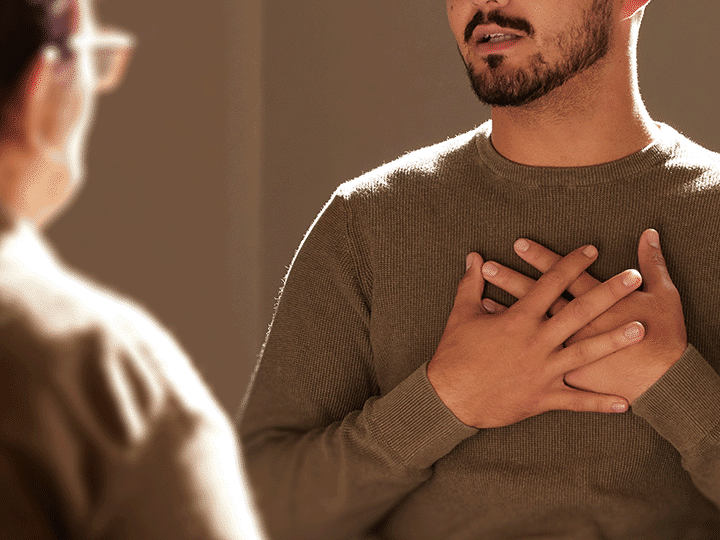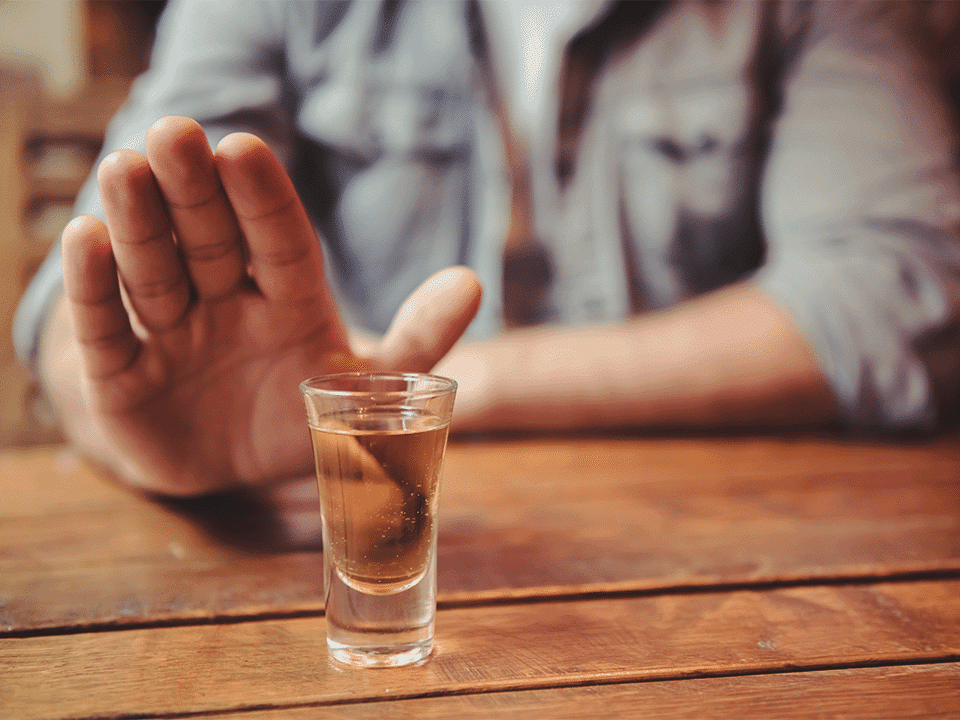If you experience persistent eye problems due to alcohol consumption or have experienced significant vision changes, visit an eye care practitioner immediately. The earlier eye issues are diagnosed and alcohol use is stopped, the better the long-term prognosis.
How Does Alcohol Impact Your Eyes?
Here are a few ways alcohol affects vision when you are intoxicated:[1-4]
Blurred Vision
Alcohol intake may cause temporary blurred vision by impacting the central nervous system, including brain function, which plays an essential role in vision coordination and eye movement coordination.
Reduced Visual Acuity
Alcohol may temporarily reduce visual acuity, making it harder to focus and see clearly. This effect often correlates with alcohol intoxication.
Eye Fatigue & Strain
Drinking too much alcohol can contribute to eye fatigue and strain, as you work to see clearly despite the negative impact on eyesight caused by drinking.
Dry Eyes
Alcohol dehydrates both your body and eyes, creating discomfort and fatigue. For this reason, dry eyes are particularly problematic with chronic alcohol abuse.
Bloodshot Eyes
Alcohol can cause bloodshot eyes due to its vasodilating effects. Alcohol widens the blood vessels, including those in the eyes, causing redness and the appearance of bloodshot eyes.
Color Vision Changes
Alcohol use can alter color vision perception temporarily. If you are intoxicated, it can affect how you perceive colors.
Increased Sensitivity to Light
Some people may experience increased sensitivity to light after consuming alcohol. Bright lights may become uncomfortable or painful to the eyes.
How Dangerous Is Alcohol Consumption for Your Eyes?
Alcohol use and abuse can have negative effects on the eyes in both the short and long term.
Short-Term Effects
Heavy drinking can cause various eye problems for someone under the influence. Here are some short-term dangers associated with heavy alcohol consumption:[1]
Abnormal eye movements, such as twitching
Reduced ability to focus
Altered color perception
Reduced contrast sensitivity
About one-third of people who have a history of migraines say alcohol is a trigger for their episodes.[21] A migraine can come with an aura, or changes in your vision before the pain comes.
Researchers say that alcohol consumption can lead to dry eye, as alcohol changes the thickness of the tears. Heavy drinkers are also more likely to fall or experience some other type of accident. These episodes can lead to penetrating injuries or other forms of eye trauma.[22]
Long-Term Effects
Prolonged heavy drinking can cause nutritional deficiencies that may affect the eyes, such as a deficiency in essential vitamins and minerals. It can also lead to corneal damage, reduced visual abilities, and cataracts. Over time and with years of heavy drinking, there is a significant toll taken on the eye muscle and its ability to function.
Long-term effects of drinking on the eyes and eyesight include the following:[1-9]
Alcoholic Optic Neuropathy
Chronic alcohol abuse can lead to optic neuropathy. With this condition, the optic nerve is damaged, resulting in progressive vision loss.
Alcoholic optic neuropathy caused by a vitamin deficiency can be treated, and vision typically improves within six weeks to six months. But other forms of neuropathy, including those caused by methanol poisoning, can lead to complete blindness.[14]
Macular Degeneration
Long-term heavy drinking is associated with an increased risk of age-related macular degeneration (AMD), a leading cause of vision loss in older adults. AMD affects the macula, the central part of the retina that is responsible for sharp vision.
Cataracts
Heavy alcohol use may increase the risk of developing cataracts, a clouding of the lens of the eye, leading to blurred vision and eventually blindness if left untreated. Cataracts can be treated with cataract surgery, which replaces the natural, clouded lens with an artificial lens.
Dry Eye Syndrome
Chronic alcohol consumption can contribute to dry eye syndrome, causing discomfort, irritation, and a gritty sensation in the eyes due to decreased tear production.
Conjunctival & Corneal Disorders
Alcohol abuse can lead to conjunctival and corneal disorders, causing inflammation, redness, and irritation of the conjunctiva and cornea.
Crossed Eyes
Alcohol abuse can impair eye muscle coordination, potentially leading to strabismus, commonly known as crossed eyes. The eye muscles no longer work together effectively, and this can cause the eyes to appear crossed.
Retinal Vascular Disease
Alcohol abuse can contribute to retinal vascular disease. This affects blood vessels in the retina, potentially causing vision problems that can even progress to blindness if untreated.
Glaucoma
Chronic alcohol abuse may increase the risk of developing glaucoma. The increased pressure in the eye that is associated with glaucoma can damage the optic nerve, leading to vision loss.
Higher Risk of Eye Infections
Chronic alcohol abuse takes a toll on overall health, weakening the immune system’s function. As a result, the body is more susceptible to infections, including eye infections. The potential for damage from these infections is also higher.
Treatment Options for Alcoholic Eyes
The first and most crucial step to treating alcoholic eyes is to stop alcohol consumption. If the person has AUD, they shouldn’t suddenly stop drinking on their own. They need comprehensive addiction treatment, often involving the use of medications, to safely stop. Without medical assistance, alcohol withdrawal can trigger potentially life-threatening symptoms.
After withdrawal, alcohol addiction treatment should involve therapy to address root issues that led to alcohol abuse.
In cases where alcohol abuse has led to neurological problems affecting the eyes, consult a neurologist. You can start with an eye doctor, like an optometrist or ophthalmologist, and they may then refer you to other specialists for further diagnosis and treatment.
Here are potential treatment options for eye-related problems associated with alcohol abuse:[1-2]
| Alcoholic optic neuropathy | Some people develop optic neuropathy due to vitamin deficiencies. A treatment plan that replaces these lost vitamins and ensures complete nutrition could help to repair or restore vision.[14] |
| Macular degeneration | Treatment for macular degeneration can involve drugs injected into the eye or laser-based therapies. Dietary supplements can also help some people to slow down macular degeneration.[15] |
| Cataracts | Surgery is the only way to treat cataracts.[16] Doctors remove the clouded lens and replace it with a synthetic version. |
| Dry eye syndrome | Over-the-counter eye drops are the most commonly used treatment for dry eyes. If the condition doesn’t improve with drops, doctors can use prescription medications to increase tear production.[17] |
| Crossed eyes | Doctors use therapies like eyeglasses, prism lenses, and eye muscle therapy to help people overcome strabismus. In severe cases, doctors use surgery to change the length or position of the eye’s muscles.[18] |
| Glaucoma | Prescription eye drops are often helpful for people with glaucoma. If they don’t work, your doctor can use laser treatments or surgery to reduce the pressure in your eye and improve your vision.[19] |
| Infections | Viral eye infections often respond to artificial tears or mild steroid drops. Bacterial infections are treated with antibiotic drops and pills.[20] |
Treatments for alcoholic eyes will depend on the condition in question. For example, dry eye may be treated with artificial tears, prescription eye drops, or ointments. Cataracts may warrant monitoring until cataract surgery is needed. Glaucoma can be managed with medications, laser therapy, or surgery.
AMD may warrant injections (anti-VEGF), photodynamic therapy, or laser treatment to slow its progression and limit vision loss. Retinal disorders may be treated with injections, laser therapy, or surgery.
Warning Signs of AUD
An estimated 28.8 million adults ages 18 and older in the United States have AUD.[12] To diagnose the condition, doctors ask a series of questions. Answering them can help you understand if you might have a problem with alcohol.
Answer the following questions using the past year as a time frame:[12]
| Have you drank more or longer than you intended to? |
| Have you tried to stop drinking or cut back but couldn’t? |
| Have you spent a lot of time drinking or recovering from drinking? |
| Have you wanted a drink so much that you couldn’t think of anything else? |
| Have you found that drinking interferes with your home life, your job, or your school work? |
| Have you kept drinking despite those troubles? |
| Have you given up or cut back on activities so you could drink? |
| Have you gotten into situations while drinking that increased your risk of getting hurt? |
| Have you kept drinking even though it made you feel depressed or anxious? |
| Have you kept drinking even after having an alcohol blackout? |
| Do you need to drink more to get the effect you want? |
| Have you experienced withdrawal symptoms (like hallucinations or shaking) when you tried to quit? |
People with AUD may be unable to fulfill their obligations, and they may face legal problems (like arrests) due to their alcohol use. They may experience problems like blackouts and hangovers regularly, and they may complain about stomach pain or heart palpitations.[13]
People with AUD may try to hide their drinking or deny it. However, they may grow annoyed when people ask about their drinking. They may also need a “morning drink” to steady their nerves or deal with alcohol hangovers.[13] These signs may indicate that someone you love needs your help.
Help for Alcohol Abuse
While eye issues related to alcohol abuse should be treated by an eye care specialist, the root cause of alcohol use disorder must be addressed. Without proper treatment for alcohol abuse, treatment for eye issues will be negated.
If you or someone you love is struggling with alcohol abuse, reach out for help today. With comprehensive addiction treatment, including medical detox and personalized therapy, you can safely stop misusing alcohol and begin to build a better future in recovery.


11 Signs You Might Have a Drinking Problem
Alcoholic Eyes FAQ
Here are some of the top questions regarding alcoholic eyes:
Alcohol abuse can cause various types of damage to the eye, even permanently damaging the optic nerve or contributing to conditions like macular degeneration, cataracts, or glaucoma. In the short term, alcohol abuse can cause eye discomfort, blurry vision, bloodshot eyes, and sensitivity to light.
While alcoholic eyes is not a medical term, it is often used colloquially to reference eye issues related to alcohol abuse. When people use the term, they are often referencing eyes that are bloodshot, watery, puffy or swollen, droopy, or irritated.
Yes, alcohol consumption can lead to red or bloodshot eyes. Alcohol acts as a vasodilator, which relaxes and expands blood vessels throughout your body, including in the eyes. This can give the conjunctiva (the white part of the eye) a red or pink appearance.
In addition, dryness and irritation from alcohol consumption can cause eye discomfort. This can lead someone to rub their eyes, creating more redness.
Redness in the eyes due to alcohol typically dissipates once your body metabolizes the alcohol. However, chronic heavy alcohol use may lead to prolonged eye redness.
Alcohol has the ability to significantly affect eye pressure in the following ways:[1-2,9-11]
Vasodilation: Alcohol acts as a vasodilator, meaning it relaxes and expands blood vessels to increase the rate of blood flow, which can potentially alter eye pressure.
Intraocular pressure: Alcohol may temporarily raise intraocular pressure (IOP).[4] An elevated IOP can be particularly concerning for individuals with glaucoma, an eye disease characterized by increased eye pressure that damages optic nerves and leads to vision loss.
Dehydration: Alcohol can act as a diuretic, leading to more frequent urination and possible dehydration, potentially disrupting fluid balance in the eyes and eye pressure levels.
- Alcohol and the eye Karimi, S., Arabi, A., Shahraki, T., Journal of Ophthalmic and Vision Research. 2021 Apr-Jun; 16(2): 260–270. Published April 2021. Accessed October 5, 2023
- Ocular manifestations of drug and alcohol abuse Peragallo, J., Biousse, V., Newman, NJ., Current Opinion in Ophthalmology. 2013 Nov; 24(6): 566–573.
- The relationship between alcohol consumption and dry eye Magno MS, Daniel T, Morthen MK, et al., The Ocular Surface. 2021;21:87-95.
- Effects of acute alcohol ingestion on eye movements and cognition: A double-blind, placebo-controlled study Silva JBS, Cristino ED, Almeida NL de, Medeiros PCB de, Santos NA dos., Paterson K, ed. PLOS ONE. 2017;12(10):e0186061.
- Different amounts of alcohol consumption and cataract Gong Y, Feng K, Yan N, Xu Y, Pan CW., Optometry and Vision Science. 2015;92(4):471-479.
- The effect of chronic alcoholism on the conjunctival flora Gunduz G, Gunduz A, Polat N, Cumurcu BE, Yakupogulları Y., Current Eye Research. 2015;41(6):734-739.
- Chronic alcohol consumption and corneal pathologies: the role of aldehyde dehydrogenases Ansari N, Zhang M, Wang C, Papaconstantinou J, Vasiliou V, Kaphalia B., Investigative Ophthalmology & Visual Science. 2013;54(15):4295-4295.
- Alcohol and the immune system Sarkar, D., Jung, M.K., Wang, H.J., Alcohol Research: Current Reviews. 2015; 37(2): 153–155.
- Effects of consumption of alcohol on intraocular pressure: Korea National Health and Nutrition Examination Survey 2010 to 2011 Song, J.E., Kim, J.M., Lee, M.Y., Jang, H.J., Park, K.H., Nutrients. 2020 Aug; 12(8): 2420.
- Alcohol, intraocular pressure and open-angle glaucoma: A systematic review and meta-analysis Stuart KV, Madjedi K, Luben RN, et al., Ophthalmology. Published January 2022.
- Alcohol consumption, genetic risk, and intraocular pressure and glaucoma: The Canadian longitudinal study on aging Grant A, Marie-Hélène Roy-Gagnon, Bastasic J, et al., Investigative Ophthalmology & Visual Science. 2023;64(10):3-3.
- Alcohol’s effects on health. National Institute on Alcohol Abuse and Alcoholism. Published January 2024. Accessed February 4, 2024.
- Understanding alcohol use disorders and their treatment. American Psychological Association. Published 2012. Accessed February 4, 2024.
- Toxic and nutritional optic neuropathies—An updated mini-review. Baj J, Forma A, Kobak J, et al. International Journal of Environmental Research and Public Health. 2022;19(5):3092.
- Age-related macular degeneration (AMD). National Eye Institute. Published June 22, 2021. Accessed February 4, 2024.
- Cataracts. National Eye Institute. Published November 15, 2023. Accessed February 4, 2024.
- Dry eye. National Eye Institute. Published November 15, 2023. Accessed February 4, 2024.
- Strabismus (crossed eyes). American Optometric Association. Accessed February 4, 2024.
- Glaucoma. National Eye Institute. Published November 15, 2023. Accessed February 4, 2024.
- I have a bacterial infection. American Academy of Ophthalmology. Published November 3, 2021. Accessed February 4, 2024.
- Alcohol and migraine. American Migraine Foundation. Published December 13, 2022. Accessed February 4, 2024.
- Ocular manifestations of drug and alcohol abuse. Current Opinions in Ophthalmology. 2013;24(6):566-573.












